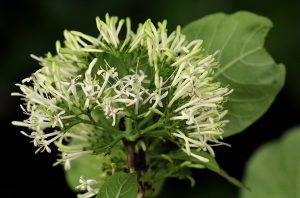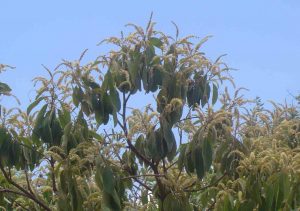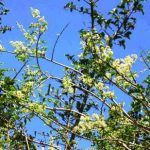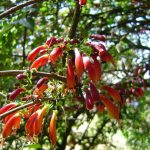TREE LIFE
May 1995
The reminder that the 1995/96 subs ($40) were due in April. Please pay promptly and add $1 for cheques drawn out of Harare.
MASHONALAND CALENDAR
Tuesday 2nd May: Botanic Garden Walk at 1645 for 1700 hours. We will meet Tom in the Public car park of the Gardens. If we finish with Combretaceae Tom will start on the Acacia species.
Saturday 20th May: Mark’s walk is brought forward a week because of the RIFA trip. Back to the Blatherwick Avenue side of the Mukuvisi Woodlands to note developments there since our last visit in Feruary 1994.
Sunday 21st May: The AGM this year will be held on Templeton Ranch in the Banket area and our hosts are Nino and Ann Bianchi. We will meet at 0915 for a cup of tea/coffee before the meeting which will start at 1000. Donations of cakes or sandwiches will be very welcome. Bring a chair and a cup for some of Ann’s soup at lunch.
May 25th to May 28 inclusive: RIFA Although fully booked your name can be put on the waiting list in case of cancellations, to book please phone Maureen Silva Jones. Those who have confirmed bookings please pay your $325 now, by cheque in favour of the Tree Society.
MATABELELAND CALENDAR
Sunday 7th May: Sincere apologies for the mix up about the trip to the Bickle family farm which actually takes place today. We depart promptly at 0830 hours from the Girl’s College car park.
CHAIRMAN’S REPORT 1994/95
An incredulous query earlier this year was “You want to look at trees?”Yes, we certainly look at trees as they form the structure for the Society and also provide a link to the host of botanically related topics Its an absorbing and fascinating environment so if plants are not your ‘thing’ enjoy the walks, it’s important that you go away refreshed and hopefully with a little more knowledge about the world around us.

Pavetta eylesii. Photo: Bart Wursten. Source: Flora of Zimbabwe
The past year’s outings have been varied, some to new and unexplored places as well as revisiting old favourites; the riverine woodland at Marsala Farm in June, the startling results of the July frost near Marondera, huge sausage pods on Kigelia africana at Chegutu in August and again in August when members from Bulawayo, Centenary and Harare met at La Rochelle for a few really enjoyable days. Other exciting venues followed with the Bulawayo Branch to Hendricks Pass in the Matopos with Ian McCausland striding out ahead like a latter day Hendrick Potgieter! Euphorbia confinalis and Clem Von Vleit’s sandwiches! And to Buchwa Mountain which, with its surrounds, including the enormous cavern of an open cast mine were fascinating. October brought very early rain and Lundhurst Farm was investigated from under dripping hats and raincoats, a very excited Ann Bianchi at Barwick Koppies in November and Meeting Kim and Cecile at a social in December. Leopard Rock Nature Reserve was visited in Bulawayo in January, while Harare prowled about the magnificent M’torcha Mountain complete with Pavetta eylesii.
Sadly we have to report the passing of three of our members, GillMasterson in October, Rob Pare in the tragic air crash at middle Sabi and Charles Sykes in Bulawayo in March. The best memories of these wonderful people would probably be of Gill striding ahead of a learner group armed with a docket stick for snakes and pads for black jacks through thick grass. Rob Pare, one of Zimbabwe’s foremost lepidopterists, patiently explaining and re-explaining the delicate feeding habits of butterflies on their favourite leaves and Charles Sykes, who with his classical background shed so much light on the confusing area of plant names. We, as individuals, and a society have benefitted so much from their contribution and our sympathies go out to their families.
Tree Life keeps us in touch, with dates and directions, with Mark’s carefully recorded facts from our botanical walks, reports by members on various outings and Benedicta’s enthusiastic articles. Over the last few years Thora’s Herbal Hints and Lyn Mullin’s wide ranging articles have been extremely interesting and a pleasure to read. Very many thanks to you all. Benedicta has finally ‘signed off’ from Tree Life after a considerable number of articles and we will miss them very much. The addressograph system of labeling Tree Life has been superseded by printed labels, than you Peg for keeping the equipment running for so long. The collating and posting is carried out by Vida, to whom we are most grateful. Within an organization such as ours there is always somebody who is the ‘kingpin’ and that is Maureen who gently reminds us that a recce is needed, edits Tree Life and continues to develop the tree mapping project. May we take the opportunity to say thank you very much indeed. Just when Peggy and Margaret had got to grips with Bequaertiodendron the name changed to Englerophytum. Not an easy job and really appreciate the trouble you take.
Thom Muller was eventually persuaded that the collection really was for him and at a function in November we were able to say thank you or the enormous amount of help given over the years. Many thanks to Trevor and May Gordon for coming in from Darwendale to present Thom with the gifts and for the very amusing recollections of the Gordon/Muller collecting trips. From all of us, very many thanks Thom for your wonderful Botanical Garden walks.
After every collecting trip the pressed specimens are placed under the gaze of Bob Drummond for identification, verification and if necessary, criticism. Bob thank you for our time and knowledge which is invaluable.
A very big thank you to all our hosts who welcome us, often with tea, and who are happy to let us wander about their farms.
Onto more mundane matters, unfortunately escalating costs of paper and printing have made it necessary to increase subscriptions. Hopefully the current level of subs can be maintained for the foreseeable future.
The Cup Fund was launched at the last AGM and gratefully received donations from Meikles and members produced sixty cups and saucers and two healthy tea pots. Many thanks to all who contributed.
Where to for next year? Hopefully much of the same lines. Several exciting venues are planned and I hope that you will enjoy them.
To Ian and the committee in Bulawayo, the outings we’ve been on with you have been tremendous and to the Harare Committee thank you for your support and interest over the last year.
-Andrew MacNaughtan
From a recent letter more about the magical Buchwa, which it is hoped to visit again this year.
“Your last circular had a trip to Buchwa Mountain and this made me think back to my youth when I was teaching in the then Shabani. We used to look out to the horizon at that mountain riding blue and high like an azure ship far away and on the many hot days it always looked inviting. However, we were told that a Government Official had once gone there and during the night had had all his tents blown down b very strong winds and we also heard that on the top of the mountain was a lake containing “hairy fish”. It was not a place to visit lightly…….. In 1947 I and some friends did make the journey there and what a memorable day it was too. We climbed to the top and I can remember puffing my way up through all the lovely Brachystegia glaucescens, some festooned with old man’s beard. From the crest we could se so far and we walked about but saw no lake with any kinds of fish. In the concave sweep to the rear of the mountain were some old citrus groves, very overgrown, but we wondered who had planted them. We had also heard that there were leopards so took good care to keep together. It was all pristine, no mining there is those days, but on our return trip we called in at the Mnene Mission and had some welcome tea with the kind Bergmans who were there then.
I wish that I had had some botanical knowledge in those days to identify some of the trees and bushes through which we climbed, but all I recall now is the tall mountain trees and the beauty of the whole expedition. I am sorry I did not go on this last trip but we seem to do so much travelling that I miss most of your outings.” Mrs. P. N. Bellingan
Marussino Farm. 19th March 1995
These were kopjes of note and Robbie and Mikey who were resistant to the heat, made it to the top in a few minutes. The rest of us shifted slowly between patches of shade alternating between magnificent bushmen paintings and plant life. In spite of the distractions 67 ‘ticks’ were placed on the card and surprisingly we found no Acacias and only one Commiphora, C.mollis.
In the coolth of a rocky cleft Rob Burrett once again rose to the occasion and gave a most interesting summary of bushman behavior and paintings. These particular paintings were exceptionally good despite 2000 years plus of exposure to the atmosphere, including the every present threat of dripping water, exfoliation of rock, changes in the surrounding microclimate and of course, acids and fats deposited by exploring fingers! Human figures and animals were plentiful and nearby another painting depicted a great throng of female figures and a group of four squat objects resembling flour sacks dumped in a corner. In all probability the painters were expressing some form of stress in their life, an earlier version of Monday morning blues!
Sharing the leafy cool we found Englerophytum magalismontanum, stem-fruit, of impressive size and Maytenus undata, waxy green leaves highlighted with clusters of yellow fruit. Returning our eyes to ground level a Scadoxus multiflurus, complete with the remains of a pin cushion flower, welcomed our return into the sunlight. Some of the other species in the vicinity were Tricalysia niamniamensis, Swartzia madagascariensis, Zanha africana and an old friend, the soap nettle, Pouzolzia mixta. Out in the hot sun Vida was seen ‘enthusing’ over the large, spreading pink bole of a Sterculia quinqueloba, the sticky sweet scent of its flowers wafting about as the hot breeze scurried about the kopje. Around the back of the kopjes undisturbed except for the yearly burnings everything grew to maximum size. A couple of enormous Brachystegia glaucescens on each side of a large balancing rock were worth a photograph especially with the distant blue hills of the Great Dyke behind. For those of us who wandered towards the beacon, Anne and others warned of a tree nettle, Obetia tenax, nearby. Sure enough, in a shady spot, between boulders, lurked the spine riddled monster, leaves and stem covered with stinging weapons, watch out. Not far from the beacon, crashing around in blackjack infested grass, we spotted a truly magnificent Mukwa, Pterocarpus angolensis with forked trunk and spectacular bark. The climb to the beacon via the steel ladder was interesting in itself, the metal red hot to the touch. Once on the top the view was breathtaking, the distant Dyke Hills, Banket through binoculars, over to Darwendale and not forgetting the herd of blesbuck below in the game park.
Gary and Sandie, thank you very much for sharing your magic kopjes with us. Thanks to Dave and Sue for suggesting the idea and for doing the recce. Rob’s talks on bushmen and their handiwork are a pleasure to list to, many thanks.
-Andy MacNaughtan
Botanic Garden Walk. 4th April 1995
Continuing with Combretaceae and this time Thom showed us various members of the Terminalia group. In general the species is characterized by a horizontal layered branch structure, highly distinctive flat fruits, often red when mature and dark, rough fissured bark.
The two look alikes, Terminalia sericea, the silver Terminalia, need little describing and Terminalia brachystemma have a small but distinct feature that separates them and that is the latter has more rounded leaves that are hairless or glabrous compared to the obvious silvery sheen of its relative. A feature common to both is the bark peeling on new branchlets. As both species hybridize easily, field identification may be interesting. Terminalia sericea is a successful pioneer and invader countrywide while the other is often found on marginal jesse belts that have been disturbed. T.tricopoda may in fact be a hybrid but differs from the above in that its large leaves are covered with brown hairs on the underside and the upper surface is glabrous. An ornamental tree except that the leaves drop in profusion at the end of summer creating a pile of leaf litter. Another familiar species easily recognized by the small scars or craters left in the branchlets from the tight cluster of leaves is Terminalia stenostachya. Generally this species prefers broken or previously eroded country, being a common variety in the Mutoko area. Terminalia mollis can be a large erect tree with larger than expected pale fruits and substantial leaves with hairy undersides and dark green upper surface. The young branchlets are also covered in fine brown hairs.

Terminalia gazensis. Photo: Bart Wursten. Source: Flora of Zimbabwe
An inhabitant of the moist outlying hills like Belingwe, Buchwa etc, is Terminalia gazensis and this species has a somewhat yellow appearance and its layered structure supports clusters of droopy leaves which have a hairy fringe. We noticed numbers of these on our last trip to Buchwa Mountain. An exception to the features noted above is Terminalia sambesiaca, a medium to large tree found along watercourses in the Zambezi Valley and is noticeable by its smooth grey bark. A small but well defined drip tip on the leaves was obvious and Thom mentioned that the thin bark of this species makes it fire tender.
The hardcore lowveld species are characterized by leaf clusters growing on stubby branchlets or spurs which are often spine tipped, Terminalia randii does this with a pair of spines protruding from behind the clusters of very small pale leaflets. The fruits too are very small and are suspended on a fragile stalk. This is an erect tree with a haphazard layering of branches and its big leaves give it a fuzzy appearance. More common in the western districts and has been recorded in serpentine soils on the Dyke near Chegutu. Possibly the most distinctive of all the Terminalia group would be Terminalia stuhlmannii, wide as it is high with the laying branches resembling clock hands positioned at 10 to 21. The thick spurs with single spines grow mainly from the upper surface of the branches whereas with the deep green untidy structure of T.prunioides, the spurs grow all round the branches. Of the two Terminalia prunioides is probably better known as its fruit is spectacular when mature in the autumn.
With the Pteleopsis species some helpful pointers are:
Pteleopsis myrtifolia has 2 winged terminalia like fruits usually lacking an apical peg, small opposite leaves that are hairy, wavy and a brighter green than Pteleopsis anispotera. P.anispotera is usually more common away from forests and the fruit is generally 4 winged usually with a distinct apical peg and smaller than that of P.myrtifolia. So for absolute certainty the answer may have to be “onto your hands and knees, and scratch for a hidden fruit”.
Once again, many thanks to Thom for a most informative and enjoyable walk.
-Andy MacNaughtan
THE HOLE IN THE OZONE LAYER AND THE SKIN PROTECTION FACTOR
The Ozone Layer: Ozone is a natural gas found in the earth’s atmosphere and the concentration is highest in stratosphere at about 25 – 30km from the earth’s surface. The ozone layer forms a protective cover absorbing certain wave lengths of the sun’s ultra violet radiation.
The harmful effects of the Hole in the Ozone Layer: High doses of ultra violet radiation are harmful, in particular UVA and UVB, and can damage the human eye, cause skin cancer, reduce plant growth affecting forests, cash and food crops, destroys plant life upsetting the ecosystem. Excessive UVB radiation suppresses the body’s immune system. A 10-15% in the reduction of the ozone in the ozone layer is estimated to cause a 20% increase in skin cancer by the year 2000. Inflammation of the eyes and eye cataracts are expected to increase. An estimate is that a 1% depletion of the ozone layer would give rise to 100000more cases of cataracts. Damage to the eyes of sheep in New Zealand has been attributed to the hole in the ozone layer.
How the ‘hole’ is formed: Ozone is a module made up of three atoms of oxygen. The ‘hole’ is not a gaping hole as such, but an area where there is far less ozone allowing harmful UA and UVB rays to the earth’s surface.
The ozone layer is probably some 15 km wide and the ozone content can be compressed into about 3 cm, but in the Southern Hemisphere, this has become much thinner causing the ‘hole’. The sun’s radiation breaks down chlorine and bromine radicals in the atmosphere. The worst ozone-depleting components are the CFCs used in aerosol propellants. CFC is an abbreviation for chlorofluorocarbon. The chlorine (Chloropart) is released by the sun’s energy and grabs one of the oxygens from the ozone to make chlorine monoxide, setting free and oxygen and chlorine molecule.
The ozone molecule is broken into different parts by combining with the chlorine and a single chlorine atom is left to continue the destruction with the next ozone molecule. It is estimated the liberated chlorine atom can take part in as many as 100 000 similar reactions before being swept out of the stratosphere into the troposphere. It does not take much imagination to see the potential damage a single CFC molecule can do in the ozone layer. So serious is the situation that 80 countries have come together in the Montreal Protocol to ban or phase out ozone depleting substances.
The hole is above the Southern Hemisphere because the earth spins like a top at a slight tilt and the CFCs in the atmosphere are spun to the south. The pollution comes from the northern most industrialized nations.
Protection from UVA and UVB: Eyes should be given protection and one of the best methods is the use of a wide brimmed hat if exposed to midday sunlight. Loose cotton clothing is a good protection for the skin and is worn as the National Dress in Arab counries.
However, fair skinned people want the bronzed glamorous ‘healthy’ look and acquire this by shedding their clothing and getting a sun tan or in slang terms catching the rays.
The indigenous people of Arica are fortunate because their skin is dark with a protective pigment called melanin.
The pale European type skins are classified
- Skin which burns and never tans
- Skin which burns readily and tans slightly
- Skin which burns and tans moderately
- Skin which tans readily
To protect these skins and allow some degree of tanning are a range of lotions having compounds filtering off the UV radiation. These products have a range of effectiveness which is ranked and referred to as the Skin Protection Factor SPF.
Remember to read the label not only will it give the SPF but it should tell if the lotion is water soluble i.e. it will wash off in the swimming pool and should be re-applied after swimming.
The ‘hole’ in the ozone layer is going to be with us for some time and there is a need to create an awareness of the potential dangers, the need to be sensible and the selection of the right SPF.
-Mary Toet
ANDY MACNAUGHTAN CHAIRMAN



